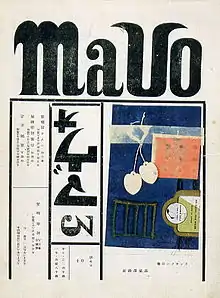Mavo
Mavo was a radical Japanese art movement of the 1920s. Founded in 1923, Mavo was productive during the late Taishō period (1912–26). Mavo re-instituted the Japanese Association of Futurist Artists, the anarchistic artist group who displayed an outdoor exhibit in Ueno Park in Tokyo in protest of conservatism in the Japanese art world.[1]


Led by Tomoyoshi Murayama, the group deployed an interdisciplinary array of performance art, painting, illustration and architecture, to communicate anti-establishment messages to the mainstream. Fueled by responses to industrial development, the Mavo group created works about crisis, peril and uncertainty. Art historian Gennifer Weisenfeld has written that Mavo sought to reintegrate art into daily life.[2]
"Mavoist" artists sought to disrupt or blur the boundaries between art and daily life. They rebelled against the establishment by combining industrial products with painting or printmaking, usually in collage form. Their performance art protests against social injustice deployed theatrical eroticism, that mocked public norms for morality at the time.[3][2]
History
Predecessors
Before the Meiji state, Mavo's predecessors engaged in Western-style painting (yо̄ga), which was promoted by the Tokugawa government.[1]
Early years
Founder members of Mavo were Murayama Tomoyoshi, Oura Shuzo, Yanase Masamu, Ogata Kamenosuke, and Kadowaki Shinro. The group expanded quickly between young artists.
During a 1923 demonstration, Takamizawa Michinao, one of the members of Mavo, threw rocks in protest, through a glass ceiling of a building housing an exhibition of artworks curated by Nika-kai (The Second Society). Nika-kai was established in 1914 to oppose the conservative Bunten, the governmental Ministry of Education Exhibition. Murayama had spent 1922 in Berlin where he became familiar with the social satire painting of Georg Grosz, Wassily Kandinsky's "spiritual" abstract paintings, El Lissitzky's constructivist works, and Alexander Archipenko's sculptures.[4] As a cultural leader and public figure, Murayama had a confident, flamboyant personality, an androgynous physical presence sporting a bob-hairstyle, and posing for photographs in states of undress.[5]
Associated artists

Other artists involved in the movement include Tatsuo Okada, Masao Kato, Masamu Yanase, Kamenosuke Ogata, Shuzo Oura and Shinro Kadowaki, and later Osamu Shibuya, Shuichiro Kinoshita, Iwane Sumiya, Michinao Takamizawa, Kimimaro Yabashi, Tatsuo Todai, and Kyojiro Hagiwara, among others.[2][6]
Magazine
Tatsuo Okada and Tomoyoshi Murayama edited MAVO magazine, that published seven issues between July 1924 and August 1925. The publication included essays on socio-cultural art, poetry, and theatrical texts. The pages included original linocut prints and photographic reproductions of visual art that often appropriated the work of their own members. Reuse and recycling from one project to another was one of the group's trademark strategies.[7] Originally, Mavo Magazine's third issue came with a firecracker adhered to its cover.[8]
Artists' books
Several members of the group produced short-run artist's books including Hagiwara Kyojiro's Shikei senkoku (Death Sentence),[9] an anthology of visual poetry published in 1925, and illustrated by Mavo; Ernst Toller's Tsubame no sho, (The Swallow Book) illustrated by Tatsuo Okada and translated by Tomoyoshi Murayama (1925); and Hideo Saito's Aozameta douteikyo, (The Pale-faced Virgin's Mad Thoughts) visual poetry published in 1926 and illustrated by Tatsuo Okada.[10][11]
References
- Weisenfeld, Gennifer (Autumn 1996). "Mavo's Conscious Constructivism: Art, Individualism, and Daily Life in Interwar Japan". Art Journal. 55 (3): 64–73. doi:10.2307/777767. hdl:10161/6559. JSTOR 777767.
- Weisenfeld, Gennifer (2002). Mavo: Japanese Artists and the Avant-Garde, 1905–1931. University of California Press. ISBN 9780520223387. Archived from the original on 2016-05-02. Retrieved 2016-03-05.
- Monskop.org. "MAVO". Monoskop. Retrieved 5 March 2016.
- Maerkle, Andrew (27 October 2014). "Heads Above Water: The anarchic 1920s Tokyo art movement Mavo and the internationalism of the Japanese Avant-garde". Frieze. Retrieved 28 July 2020.
- Larking, Matthew (April 26, 2012). "Mavo, the movement that rocked Japan's art scene". The Japan Times. Retrieved 5 March 2016.
- Wang, Yang (December 2009). "Russia Constructed: the Practice of Avant-gardism in Taisho-era Japan, 1912-1926" (PDF). osu.edu. Retrieved 5 March 2016.
- Gardner, William (1999). "Poetry and New Media: An Essay on the 1920s Avant-garde, Focusing on Hagiwara Kyojiro's "Advertising Tower !" 詩と新メディア : 萩原恭次郎の「広告塔!」を中心にした一九二〇年代のアヴァンギャルド論考". Comparative Literature and Culture (16).
- Gopnik, Blake. "Was Japanese Dada Even Tougher Than Its European Versions?". ArtNet News. Retrieved 28 July 2020.
- "Shikei senkoku (Death Sentence)". Museum of Fine Arts Boston. Retrieved 28 July 2020.
- Weisenfeld, Gennifer (Autumn 1996). "Mavo's Conscious Constructivism: Art, Individualism, and Daily Life in Interwar Japan". Art Journal. 55 (3): 64–73.
- "Aozameta dōteikyō : Shigashū 1926". Metropolitan Museum of Art. Retrieved 28 July 2020.
External links
- Mavo, Tangerine blog
- Denno Mavo
- Okada Tatsuo, Spencer Museum of Art